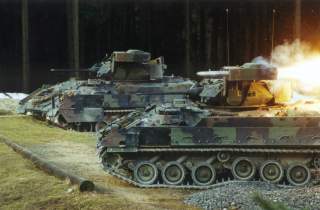Army Soldiers Will Use Special M-2 Bradley Infantry Fighting Vehicle to Control Robots
The future is now.
U.S. Army soldiers riding in a specially-modified M-2 Bradley infantry fighting vehicle will control a platoon of ground robots during an upcoming exercise in Colorado.
The planned 2020 test “moves beyond the basic ‘robotic wingman’ pursuits that have so far led how the mechanized community of the Army is getting at using semi-autonomous and autonomous vehicles,” Army Times reporter Todd South explained.
Army officials intend for the month-long exercise at Fort Carson to gather data for the service’s Ground Vehicle Systems Center. The soldiers in the exercise will operate the unmanned ground vehicles from inside upgraded Bradleys that the Army refers to as “Mission Enabler Technologies-Demonstrators.”
The upgrades include a remotely-operated turret for the vehicle’s 25-millimeter gun, extra sensors for 360-degree awareness and new crew stations with touchscreens, according to an Army release.
The Colorado war game will involve two of the special Bradley controlling a total of four UGVs, South reported.
The U.S., British and Russian militaries, among others, quickly are moving to integrate armed robots into their ground forces.
The U.S. Army has begun shopping around for a robotic armored vehicle that can replace some of the branch's old M-2 Bradley manned fighting vehicles. The 2020 war game could inform those efforts.
This “Optionally-Manned Fighting Vehicle” could operate with or without a human crew, allowing commanders to deploy the vehicles on missions that are too risky for human beings.
Some initial testing took place as early as 2017. An armed, robotic M-113 tracked armored vehicle provided covering fire for soldiers during a summer 2017 war game in Michigan.
For the exercise, engineers added a remotely-controlled machine gun to a remotely-controlled M-113. The operators of the M-113 and its machine gun followed behind the drone in an M-577 command vehicle, issuing commands via radio.
The Russian army is developing its own robotic vehicles and running experiments in order to develop tactics for deploying the unmanned systems. The new tactics point to Russia's growing determination to field, on the ground and in the air, meaningful numbers of armed robots.
The Kremlin is using the tracked, tank-size Marker ground robot for these tactical experiments. A video the Russian government released in March 2019 depicts a mixed crew of human and robot scouts feeding information to a main force of large, tank-like drones.
"Marker is built to be modular, with open information architecture," reporter Kelsey Atherton wrote. "One configuration for the testbed arms it with a Kalashnikov-produced machine gun and a part of anti-tank grenade launchers. We can safely expect to see it test a range of weapons."
Robots in the air, on the ocean surface and on the ground guarded British Royal Marines as they stormed a beach during an important April 2019 war game.
Alpha Company of the Royal Marines’ 40 Commando and their robot guardians stormed a beach in Cornwall in southwest England as part of Exercise Commando Warrior. The Royal Marines’ 1 Assault Group supported the naval infantry.
“Commando Warrior was the first time Royal Marines have used the autonomous vehicles during tactical action,” the Royal Navy reported.
The ground robot, in particular, was a new capability for the Royal Marines. The gun- and rocket-armed, tank-like unmanned ground vehicles, variants of QinetiQ’s jeep-size, tracked Titan, could boost the naval branch’s firepower while helping to keep human beings out of harm’s way.
The Royal Marines’ mock beach assault could help to inform QinetiQ’s development of more sophisticated UGVs. “Teams behind the unmanned vehicles were at Tregantle Beach to watch how the equipment performed in a live-action situation,” the navy reported.
Adding ground robots to infantry and armor units “reduces risk,” said U.S. Army major Cory Wallace, who oversees some UGV development for the service. “It does so by expanding the geometry of the battlefield so that before the threat makes contact with the first human element, it has to make contact with the robots.”
"That, in turn, gives commanders additional space and time to make decisions,” Wallace said.
David Axe serves as Defense Editor of the National Interest. He is the author of the graphic novels War Fix, War Is Boring and Machete Squad.

